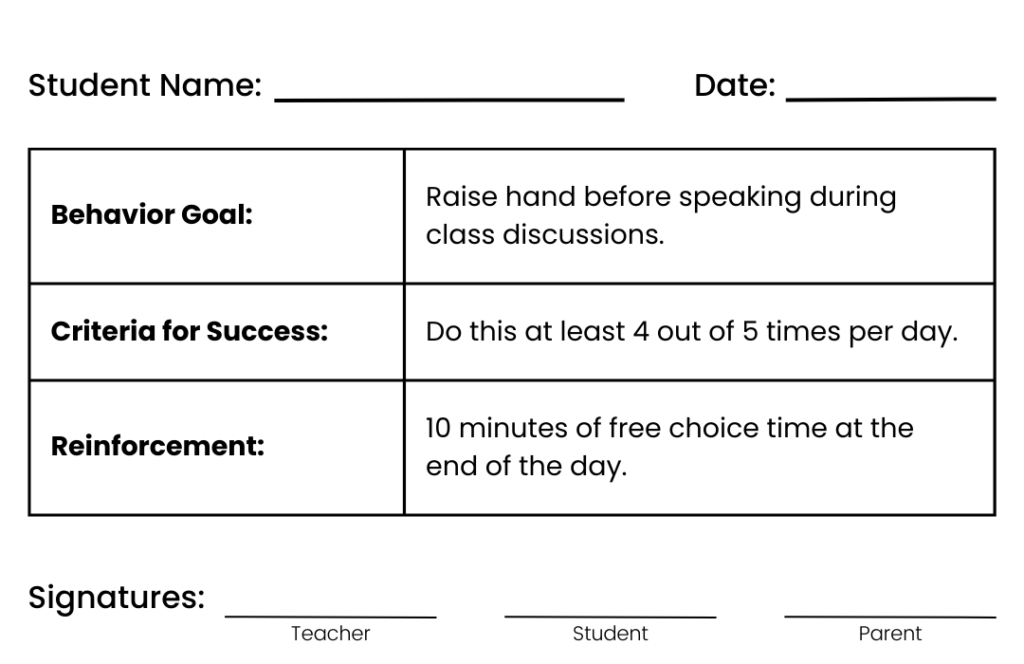Creating a structured and positive classroom environment can be challenging, especially when addressing persistent student behaviors that interfere with learning. One effective evidence-based strategy that helps to promote positive behavior is the use of a contingency contract. This tool helps teachers to clarify expectations, reinforce desired behaviors, and encourage student accountability.
Understanding Classroom Contingency Contracts
A contingency contract is a formal written agreement between a teacher (or other school personnel) and a student that clearly outlines the expected behavior, the reinforcement provided for meeting those expectations, and the criteria for success. Rooted in Applied Behavior Analysis (ABA), contingency contracts use positive reinforcement to promote desirable behaviors (Cooper, Heron, & Heward, 2020).
Benefits of Using a Contingency Contract
This strategy offers multiple advantages in the classroom:
- Defines expectations: Ensures both student and teacher understand how the student is expected to behave.
- Increases motivation: Involving students in developing the contract improves buy-in and offering a reward for positive behavior increases the likelihood that the student will engage in it.
- Promotes self-management: Encourages students to take responsibility for their actions.
- Reduces problem behaviors: As positive behaviors increase, they will replace the former behaviors of concern.
- Facilitates communication: Strengthens dialogue between teachers, students, and parents (Kazdin, 2001).
Implementing a Contingency Contract
To create an effective contract:
- Identify a specific, measurable behavior. Instead of a vague goal like “be respectful,” focus on concrete actions, such as “raise your hand before speaking.”
- Define contract terms. Specify the behavior, conditions, and frequency. For example, “If [Student] completes their math worksheet in 20 minutes, with 80% accuracy for five days in a row, they will earn 10 extra minutes of free time.” Another example is, “If [Student] uses an inside voice while in the classroom (without screaming) all day, at 3:00 [Student] may spend 15 minutes on an art activity.”
- Select meaningful reinforcers. Choose rewards that are personalized and motivating, such as extra recess time or the opportunity to choose a classroom activity. Deliver the reinforcers consistently, per the terms of the contract. The Premack Principle (“First, X; then, Y”) has proven to be an effective way to change behavior by requiring that a less preferred activity be completed prior to accessing an activity, item, or social engagement that is more preferred than the preceding activity (Premack, 1965).
- Document the agreement. Ensure the contract includes clear expectations and spaces for signatures from the student, teacher, and possibly a parent or guardian.
Example Contingency Contract
Tips for Success
To maximize the effectiveness of a contingency contract:
- Make expectations clear and achievable. Ensure the behavior is specific and within the student’s ability to complete.
- Use positive reinforcement effectively. Reinforcers should be meaningful, individualized to student preferences, provided consistently, and updated periodically.
- Monitor progress regularly. Tracking completion with checklists or charts can help reinforce accountability.
- Involve the student in the process. Giving them input increases engagement and motivation.
Adjust as needed. If a contract isn’t working, modify the terms or reinforcers to improve effectiveness.
Conclusion
By implementing a contingency contract, educators can create a structured environment where students are motivated to engage in positive behaviors. Not only does this technique improve classroom management, but it also empowers students to take ownership of their actions—a skill that benefits them far beyond the classroom walls!
References
- Cooper, J. O., Heron, T. E., & Heward, W. L. (2020). Applied Behavior Analysis (3rd ed.). Pearson.





